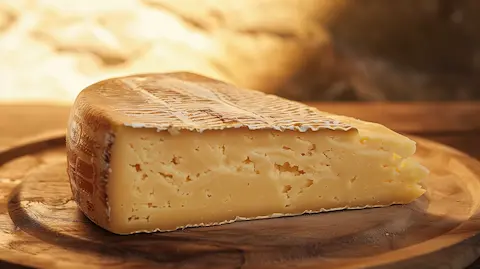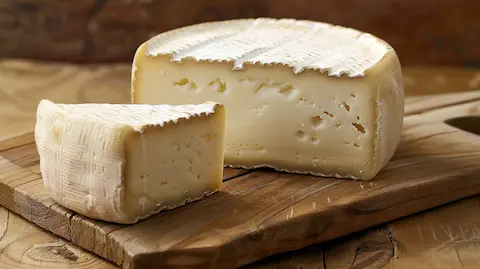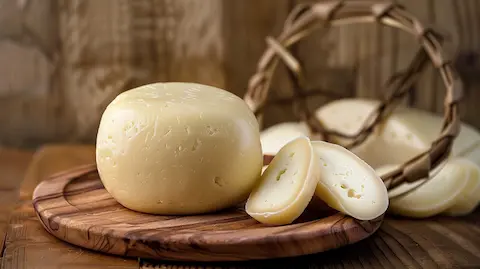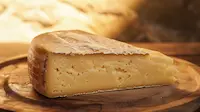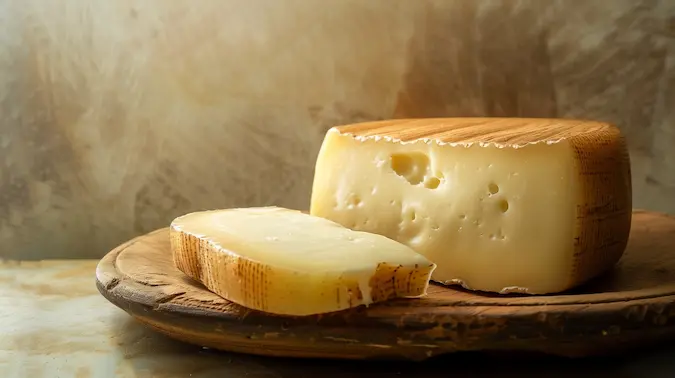Limburger Cheese
Limburger cheese is a soft, surface-ripened variety known for its strong, pungent aroma. Originating from the historical Duchy of Limburg, now located in modern-day Belgium, this cheese has a grassy, earthy flavor profile with notes of mushroom. It is crafted from pasteurized cow's milk, employing vegetarian rennet and a specific strain of bacteria, Brevibacterium linens, which is responsible for its distinctive smell.
How is Limburger Made?
Limburger cheese is made by warming pasteurized whole cow's milk and adding less than 2% cheese cultures to develop the base flavor. Salt, calcium chloride, and vegetarian rennet are introduced to coagulate the milk into curds. The curds are then shaped, brined, and left to age. During the aging process, the cheese is regularly washed with a solution containing Brevibacterium linens, which fosters the growth of the rind and contributes to the cheese's strong odor and unique taste. The aging takes place over several months, during which the cheese develops its characteristic soft, spreadable texture and robust flavor profile.
Explore the detailed production process of Limburger cheese in the table below:
Limburger Cheese Production Process
| Step | Ingredient(s) | Method | Temperature | Duration |
|---|---|---|---|---|
| 1. Warm Milk | Pasteurized whole cow's milk | Heating | 32°C (89.6°F) | Until milk reaches target temperature |
| 2. Add Cultures | Cheese cultures | Mixing | 32°C (89.6°F) | 30 minutes |
| 3. Coagulation | Salt, calcium chloride, vegetarian rennet | Adding and mixing | 32°C (89.6°F) | 1-2 hours |
| 4. Curd Processing | Cutting, stirring, and draining whey | Varies | ||
| 5. Shaping | Placing curds into molds | Until curds are firm | ||
| 6. Brining | Brine solution | Immersing cheese | Several hours to days | |
| 7. Aging | Brevibacterium linens solution | Washing and ripening | 13°C (55.4°F) | 2-3 months |
Limburger Cheese Profile
Limburger cheese boasts a rich history and a profile that intrigues cheese aficionados and curious foodies alike. With its distinct characteristics, Limburger has cemented its place in the cheese world. Below are key facts about this unique cheese:
- Made from: Pasteurized whole cow's milk
- Country of origin: Belgium
- Region: Monroe, Wisconsin; Herve area, historical Duchy of Limburg
- Family: Washed-rind cheeses
- Type: Soft, surface-ripened
- Texture: Soft and spreadable after 2-3 months of aging
- Rind: Washed, edible, develops a reddish-brown coating
- Colour: Pale yellow interior
- Aroma: Pungent, due to Brevibacterium linens
- Vegetarian: Yes, uses vegetarian rennet
- Producers: Chalet Cheese in Monroe, Wisconsin; Oak Grove Cheese Company in New Hamburg, Ontario
- PDO status: The European protected name is Herve for the variety made in Belgium
How to Store Limburger?
Storing Limburger cheese properly is key to maintaining its quality and flavor. Keep Limburger refrigerated at a temperature between 1°C to 4°C (34°F to 39°F). It should be wrapped in parchment paper or wax paper, which allows the cheese to breathe while maintaining the right humidity level. Overwrap the paper with aluminum foil or place it in a plastic container to prevent the strong aroma from permeating other foods. Check the cheese regularly and consume it within the recommended time frame to enjoy its unique characteristics at their best.
- Step 1: Wrap - Encase Limburger cheese in parchment or wax paper.
- Step 2: Overwrap - Cover the paper-wrapped cheese with aluminum foil.
- Step 3: Refrigerate - Store the wrapped cheese in the refrigerator.
- Step 4: Check - Inspect the cheese regularly for any signs of spoilage.
- Step 5: Consume - Enjoy the cheese within its optimal consumption period.
How long does Limburger cheese last?
Limburger cheese's shelf life depends on its storage conditions. When stored properly in the refrigerator, Limburger can last for up to two months. However, once opened, it's best to consume it within three weeks to savor its full flavor and texture. Freezing limburger is not recommended, as it can alter the texture and taste. If frozen, the cheese may become crumbly and lose some of its pungent aroma upon thawing.
| Storage Location | Unopened | Opened |
|---|---|---|
| Fridge (1°C to 4°C / 34°F to 39°F) | Up to 2 months | Up to 3 weeks |
Can You Freeze Limburger?
No, freezing Limburger cheese is not advised. Freezing can change the texture, making it crumbly, and can diminish its signature pungent aroma. For the best sensory experience, Limburger should be enjoyed fresh and stored as recommended.
Alternatives to Limburger Cheese
For those seeking similar cheeses to Limburger, or perhaps a milder option, there are several alternatives that can offer comparable textures and flavors. Each cheese listed below serves as a suitable substitute, depending on your taste preferences and the specific qualities you enjoy in Limburger.
Limburger Cheese Substitutes
| Cheese | Origin | Texture | Flavor | Why a Good Substitute? |
|---|---|---|---|---|
| Munster | France | Soft | Mild to strong | Similar washed-rind, pungent aroma, becomes stronger with age. |
| Taleggio | Italy | Semi-soft | Fruity, meaty | Offers a strong smell with a milder taste, creamy texture. |
| Brick Cheese | United States | Soft to semi-hard | Mild to pungent | Develops stronger flavor when aged, similar to Limburger. |
| German Tilsit | Germany | Semi-hard | Strong, spicy | Intense aroma and flavor, akin to Limburger but firmer. |
| Port du Salut | France | Semi-soft | Sweet, nutty | Less pungent, with a similar texture and moisture content. |
How to Use Limburger
Limburger cheese's robust flavor and soft texture make it versatile in the kitchen. When cutting this cheese, use a wire cheese cutter or a sharp knife to slice through its creamy body without sticking. Serve at room temperature to fully appreciate its complex flavors. Here are popular ways to enjoy Limburger:
- Spread on rye or crusty bread
- Paired with onions and vinegar as a traditional snack
- Incorporated into macaroni and cheese for a potent twist
- Melted over potatoes or burgers
- Added to salads for a pungent kick
Recipes Using Limburger
Limburger cheese, with its creamy texture and robust flavor, shines in a variety of recipes. Its ability to melt well makes it perfect for warm dishes, while its strong taste adds depth to cold preparations. Here are some popular recipes that feature Limburger cheese:
- Limburger and Onion Sandwich: The sharpness of the onion complements the intense flavor of Limburger cheese, typically served on rye bread.
- Limburger Mac and Cheese: A twist on the traditional dish, adding Limburger cheese gives a pungent kick to this comfort food favorite.
- Grilled Limburger with Bacon: The smokiness of bacon pairs well with the earthy tones of Limburger, creating a hearty and satisfying dish.
- Limburger Cheese Spread: Blended with butter and cream, this bold appetizer is served with crackers or vegetables.
- Limburger Salad Dressing: Whisked into a vinaigrette, the cheese adds a tangy and aromatic twist to salads.
Limburger Nutrition Data
Limburger cheese is not only known for its bold aroma but also for its nutritional content. There are 327 calories in Limburger cheese per 100g. This cheese also provides protein, fat, and essential nutrients, making it a hearty addition to a balanced diet. The following table offers a concise view of its nutritional value:
| Nutrient | Amount per 100g | % Daily Value* |
|---|---|---|
| Calories | 327 | |
| Total Fat | 27g | 42% |
| Saturated Fat | 17g | 85% |
| Cholesterol | 90mg | 30% |
| Sodium | 800mg | 33% |
| Total Carbohydrates | 0g | 0% |
| Dietary Fiber | 0g | 0% |
| Sugars | 0g | |
| Protein | 20g | 40% |
| Calcium | 60% | |
| Iron | 2% |
*Percent Daily Values are based on a 2,000 calorie diet. Your daily values may be higher or lower depending on your calorie needs.
What's Next? WhatCheese Insights
As a passionate advocate for the world of cheese, I'm excited to share some insights on where to find and how to savor Limburger cheese. For enthusiasts eager to explore this cheese, specialty cheese shops and European delis often stock Limburger, especially those with a focus on Belgian or Germanic fare. In the United States, Wisconsin is a hub for Limburger, thanks to its rich dairy heritage. Online retailers also offer Limburger, providing access to those who might not have a local source.
For a truly immersive experience, renowned vineyards in regions known for their cheese production often host cheese tastings. These events allow you to sample Limburger in its prime, paired with wines that complement its bold flavors. Keep an eye out for cheese festivals and fairs, which often feature a range of washed-rind cheeses including Limburger, and provide a fantastic opportunity to meet cheesemongers and learn directly from the experts.
The best time to enjoy Limburger is when it's reached its peak ripeness, typically between two to three months of aging. This is when its texture and flavor are most pronounced, offering a true taste adventure for the palate.




